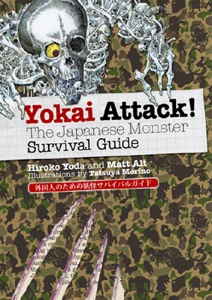Part field guide and part manga, Yokai Attack! introduces readers to a wide variety of bizarre monstrous characters from Japanese folklore and pop culture. Thoroughly illustrated with both contemporary and Edo Period artwork, the main reason to read this isn’t to live through an encounter with a a giant foot or a woman with two mouths but rather to sample from the rich tableau of fabulous creatures that inhabit the Japanese imagination.
Authors Matt Alt and Hiroko Yoda—a husband and wife team of translators—and illustrator Tatsuya Morino do an excellent job of packing a lot of information in a quick, fun read. It’s subtitled “the Japanese Monster Survival Guide” but the survival aspect is but one of its many features. The average entry is just a few pages, but with each creature profiled you’ll learn its distinguishing features (two tails, enormous testicles, long neck and so on), origins (Chinese folklore, Buddhist stories, Shinto legends, literature), attack modes (flatulence, eating your liver, crying loudly in pumpkin patches) and tips on how to defeat or avoid them (clean your bathroom, stand perfectly still, don’t walk alone in the woods).
 In addition to the beasts on display, the authors provide an overview of the waxing and waning of yokai popularity. As in the west, spooky tales never go out of fashion completely, but sometimes they enjoy a surge in the public interest. The Edo Period, for example (an era for which I have an unending fascination), was something of a golden age for yokai-related art in woodblock prints, theater and literature. The Mieji Restoration saw a decline in interest but these days they’ve come back in contemporary film, anime and manga. Here’s an interesting fact I learned from the book: long before the invention of Pokemon and Naruto, the children of the Edo Period played collectible yokai card games.
In addition to the beasts on display, the authors provide an overview of the waxing and waning of yokai popularity. As in the west, spooky tales never go out of fashion completely, but sometimes they enjoy a surge in the public interest. The Edo Period, for example (an era for which I have an unending fascination), was something of a golden age for yokai-related art in woodblock prints, theater and literature. The Mieji Restoration saw a decline in interest but these days they’ve come back in contemporary film, anime and manga. Here’s an interesting fact I learned from the book: long before the invention of Pokemon and Naruto, the children of the Edo Period played collectible yokai card games.
 Beyond the well-known Kappa, Kitsune and Tanuki, my favorite yokai in the book are the Zashiki Warashi, Obariyon and Kuchisake Onna. Zashiki Warashi is something of a good luck charm version of a poltergeist. They make messes and noise but for as long as they live with you, they bring you good fortune. The moment they split, prepare for your finances to go Enron. Obariyon is a massive lump of a creature who wants more than anything to coax unwary travelers into giving him a piggyback ride, only to grow heavier and heavier with every step. It won’t kill you, but you’ll need to see a chiropractor straight away. The Kuchisake Onna appears as a beautiful woman whose mouth is covered with a mask. She’ll ask you if you think she’s beautiful. Say yes and she’ll take the mask off, show you a wide mouth full of sharp fangs, and ask if you still think she’s beautiful. After that she’ll slash your face. If you say no, she’ll slash your face anyhow. According to the book, 99% of Japanese kids polled knew of this yokai. I asked several of my Japanese coworkers, and sure enough, every one of them knew of the Kuchisake Onno, and they all made these creepy Joker grins when I mentioned her.
Beyond the well-known Kappa, Kitsune and Tanuki, my favorite yokai in the book are the Zashiki Warashi, Obariyon and Kuchisake Onna. Zashiki Warashi is something of a good luck charm version of a poltergeist. They make messes and noise but for as long as they live with you, they bring you good fortune. The moment they split, prepare for your finances to go Enron. Obariyon is a massive lump of a creature who wants more than anything to coax unwary travelers into giving him a piggyback ride, only to grow heavier and heavier with every step. It won’t kill you, but you’ll need to see a chiropractor straight away. The Kuchisake Onna appears as a beautiful woman whose mouth is covered with a mask. She’ll ask you if you think she’s beautiful. Say yes and she’ll take the mask off, show you a wide mouth full of sharp fangs, and ask if you still think she’s beautiful. After that she’ll slash your face. If you say no, she’ll slash your face anyhow. According to the book, 99% of Japanese kids polled knew of this yokai. I asked several of my Japanese coworkers, and sure enough, every one of them knew of the Kuchisake Onno, and they all made these creepy Joker grins when I mentioned her.
So, next time you’re walking alone at night and you want to know if it’s safe to eat fruit that looks like a baby’s face or if that flaming, screaming head in the floating wheel might mean you harm, I suggest you consult Yokai Attack! and then run like hell. Or vice-versa.










